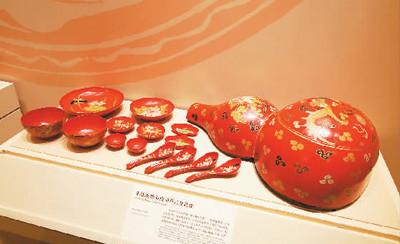Source: People's Daily Overseas Edition

Qingzhu patent leather tire painted gourd type tableware box. Photo by Du Jianpo
What was noodles like 4,000 years ago? How were the first wines and teas born? Where did cucumbers, eggplants, and carrots come from to China?
At the "Exhibition of Ancient Chinese Food Culture" at the National Museum of China, rich and diverse cultural relics, informative exhibition panels, and interesting interactive experiences allowed the audience to understand a lot of food-related knowledge and taste the Chinese taste of "people take food as the sky".
Ancient Chinese food culture is long and thick, not only containing exquisitely shaped eating utensils, self-contained cooking techniques, vast classical system, etc., but also nurturing and deriving a series of philosophical concepts, political wisdom and scientific ideas that affect the development process of Chinese civilization, and also providing an inexhaustible source for many literary and artistic creations such as traditional music, dance, painting, sculpture, poetry and so on.
The exhibition is divided into 5 units: "Eating from Eight Directions", "Tea Rhyme and Wine Aroma", "Beautiful Utensils", "Change in Dingzhong", and "Ritual Diet", exhibiting more than 240 pieces (sets) of cultural relics, starting from different angles such as ingredients, utensils, techniques, etiquette, etc., comprehensively displaying the development and changes of ancient Chinese food culture, vividly presenting the life pictures of ancient working people full of fireworks, and expressing the Chinese nation's vision and pursuit of a better life with abundant food and clothing.
In the "Eating from The Eight Directions" unit, the carbonized rice of the Liangzhu culture period and the carbonized wheat grain of the Spring and Autumn period show the Chinese grain-based dietary tradition, the vivid animal pottery figurines tell the story of "six animals and three animals", and a Ming Dynasty pottery offering dish with chickens, fish, vegetables, fruits and cakes reflects the diversified dietary structure of the ancients.
In the "Tea Rhyme and Wine Aroma" section, the tea sets and wine vessels of the past generations reflect the changes in tea culture and wine culture. Ear cup, also known as feather cup, is an ancient Chinese wine-holding vessel, with an oval shape, a shallow abdomen, a flat bottom, and a half-moon shaped amphora on both sides, resembling the wings of a bird. The scene of "meandering water flowing" in the exhibition hall reproduces the grand situation of the ancient people's elegant collection. When the ancient literati had a drink, there was a babbling water in front of them, and the wine glass drifted down the water, and whoever floated in front of him had to raise a glass and drink it all, and chanted poetry. Tea ordering is a very popular cultural activity among the literati and doctors of the Song Dynasty, reflecting the exquisite and elegant life aesthetics of the Song people. The video played in the exhibition hall introduces the complete process of the Song Dynasty tea ordering technique, and the exhibits such as black-glazed rabbits and cups are reminiscent of the wonderful scenes of the Song people fighting tea.
"Gourmet beauty matching" is the embodiment of traditional Chinese aesthetic concepts in food culture. The "Variety of Beautiful Ware" unit is divided into 5 groups: "Ancient Pottery", "Bronze Majesty", "Lacquer Wood Beauty", "Porcelain Charm" and "Golden Jade Elegance", showing the eating utensils of different materials and their importance in ancient Chinese food culture. A gorgeous set of lacquered vermilion lacquered gourd-style cutlery boxes is particularly eye-catching. As early as the Eastern Zhou Dynasty, there were tableware boxes in one vessel. This set of leather tire tableware boxes are Qing Dynasty utensils, painted with vermilion paint throughout, including large plates, small plates, bowls of different sizes, round plates, begonia flower plates, wine glasses, rice spoons, etc., and the outer walls or inner walls of the utensils are painted with folded branches, peonies, peach blossoms, plum blossoms, camellias, lotuses, etc.
The exhibition also features a number of interactive projects where visitors can try to make pastry from molds and experience the ancients' habit of eating on the ground. The curators said that they hope that through the content that is good-looking, fun and experienceable, the audience can feel the profundity of ancient Chinese food culture and perceive the taste of life of the Chinese nation through ancient and modern times. (Reporter Zou Yating)
People's Daily Overseas Edition ( 2022-01-18 Issue 07)